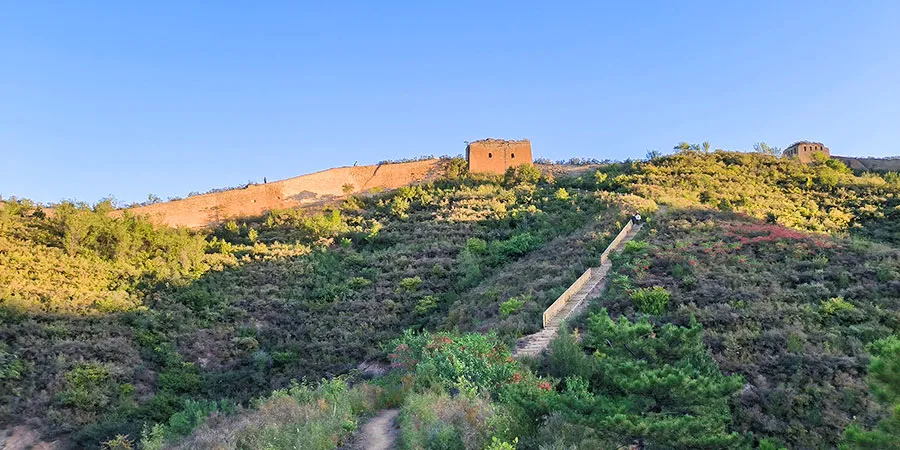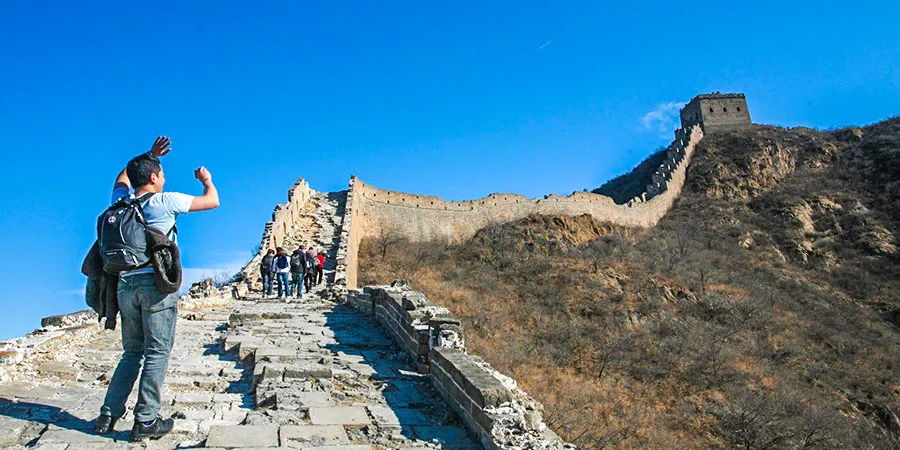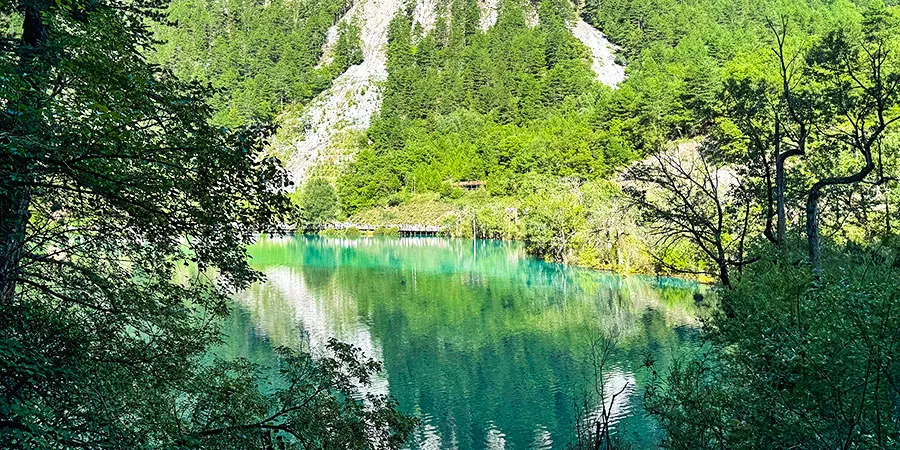Lupiguan Great Wall
The Lupiguan Great Wall, nestled in Miyun District, Beijing, is approximately a two-hour drive from the city center. As a wild section of the Great Wall, it is renowned for its breathtaking mountain and river vistas.
The Lupiguan Pass was a spectacular and solid pass in the past, which may have rivalled the Juyongguan Pass. However, this section of wall has been severely damaged by weather and human activities, and the Lupiguan Pass has disappeared. Consequently, only several three-window watchtowers and the dilapidated wall can be seen today.
Despite its dilapidated state, the Lupiguan Great Wall remains a magnet for countless hikers, drawn by its breathtaking scenery. This section of the Great Wall winds gracefully along the mountain ridge and dramatically plunges into the valley. From its summit, a panorama unfolds: to the east, Asia’s largest artificial lake, the Miyun Reservoir, stretches into the distance; to the west, the Baihe Gorge, dubbed the “Little Yarlung Tsangpo Grand Canyon,” comes into view. The Baihe River flows a U-turn here, its light-blue waters infusing the surrounding valleys with life.
- The Lupiguan Great Wall, historically called the Shitangling Great Wall, was first constructed during the Northern Qi Dynasty (550 - 577), and restored during the Ming Dynasty (1368 - 1644).
- Its current name, “Lupiguan”, literally means a pass that is like beautiful deerskin. There are two interesting legends about it. As one legend goes, the mountains on which the pass was built looked like colorful deerskin, so the pass was named the Lupiguan Pass. The other legend is that there was a huge stone in the nearby valley shaped like a deer lying down, hence the name.
- There are four watchtowers remaining at the Lupiguan Great Wall.
The entire Lupinguan Great Wall hiking trail is 10 kilometers (6.2 miles) long. Some sections require crossing through shrubbery, and some involve climbing over cliffs, making it a challenging hike that demands good physical fitness and hiking experience. Hikers with less stamina can choose to do a half-trip based on their own conditions. Here are some reference hiking routes:
 Length: 10 kilometers (6.2 miles)
Length: 10 kilometers (6.2 miles)
 Time: 5 - 6 hours
Time: 5 - 6 hours
 Route: Heilongtan Conference Center → Yangfen Tower → Mountain Top → Hebei Village → Heilongtan Conference Center
Route: Heilongtan Conference Center → Yangfen Tower → Mountain Top → Hebei Village → Heilongtan Conference Center
 Difficulty: High
Difficulty: High
 Suitable for: Hikers with good physical fitness and rich hiking experience.
Suitable for: Hikers with good physical fitness and rich hiking experience.
Starting from the Heilongtan Conference Center, there is a small slope at the entrance. Walk along the stone steps for about 1 kilometer (0.6 miles) and you will see the remains of the Great Wall. Press on about 1 kilometer (0.6 miles) to reach the first watchtower - the well-preserved Yangfen Tower, where you can enter and visit, overlooking the entire valley from the top of the tower. Continuing along the ruins, you’ll reach the mountain top, offering the best vantage point to behold the U-shaped bend of the Baihe River. Then, descend the Great Wall for about 2 kilometers (1.2 miles) to the highway section. Walk along the highway through Hebei Village for 3.2 kilometers (2 miles) to return to the Heilongtan Conference Center.
 Length: 6 kilometers (3.7 miles)
Length: 6 kilometers (3.7 miles)
 Time: 3 - 4 hours
Time: 3 - 4 hours
 Route: Hebei Village → Yangfen Tower → Mountain Top → Hebei Village
Route: Hebei Village → Yangfen Tower → Mountain Top → Hebei Village
 Difficulty: Moderate
Difficulty: Moderate
 Suitable for: Hikers with some hiking experience.
Suitable for: Hikers with some hiking experience.
Start your ascent from the left side of the Riyuexing Farmhouse in Hebei Village. The initial stretch, a mountain dirt road, is relatively easy underfoot, leading you quickly to the Yangfen Tower. Then, follow the Great Wall to the mountain top to admire the stunning sight of the Baihe River’s bend. This part features a steep slope and a few small cliffs, so watch your step. After that, continue along the Great Wall for 2 kilometers (1.2 miles) to descend and return to Hebei Village.
This route follows the same path as the small loop, starting from the left side of the Riyuexing Farmhouse in Hebei Village and climbing until you decide to turn back and then retrace your steps.
The prime months to hike the Lupiguan Great Wall are September, October, January, and February. From September to October, the maple leaves burst into a riot of red, while from January to February, the Baihe River freezes over, presenting its most beautiful appearance.
Note: There may be snow on the Great Wall in winter. For your safety, it is recommended to wear crampons.
Free of charge
It is a wild Great Wall and can be visited at any time of the day.
- From Dongzhimen Bus Station, take the 980 Express to Miyun Binhe Daqiao bus stop. Then, a short 10-meter (11-yard) walk will bring you to the Yanhu Ximen bus stop on the same street.
 For those hiking the big loop route:
For those hiking the big loop route:
- Take Bus No. Mi60/Mi61/Mi62 from Yanhu Ximen bus stop to the Heilongtan bus stop.
- Cross the bridge and walk northeast for about 1.5 kilometers (0.9 miles) to the Heilongtan Conference Center.
 For those hiking the small loop route:
For those hiking the small loop route:
- Take bus No. Mi60/Mi61/Mi62 from Yanhu Ximen bus stop and get off at Hebei Village stop.
- Walk about 180 meters (200 yards) north to reach the Riyuexing Farmhouse.
Bus schedule:
Given that public transportation is time-consuming and the bus stop is far from the destination, with the risk of missing the last bus on the return journey, renting a car with a driver offers a more convenient and quicker option. The one-way journey takes around 2 hours, with a cost of CNY 700 - 1,200 per day.
1. As there are several cliffs along the hiking route, teamwork is essential. Hiking in a group is highly recommended.
2. Since it’s a wild Great Wall with no food vendors, make sure to pack enough food and water.
3. Some sections have loose stones, so always watch your footing and ensure a firm step before moving forward.
4. There may be wild boars in the valley, so please be careful.
Wild Great Wall in Beijing
Best Great Wall Hike: Top 5 Wild Hiking Routes
20 Great Wall Hiking Tips You Should Know
Great Wall Hiking Checklist: 15 Things that Expert Hikers Always Take
The Lupiguan Pass was a spectacular and solid pass in the past, which may have rivalled the Juyongguan Pass. However, this section of wall has been severely damaged by weather and human activities, and the Lupiguan Pass has disappeared. Consequently, only several three-window watchtowers and the dilapidated wall can be seen today.
Despite its dilapidated state, the Lupiguan Great Wall remains a magnet for countless hikers, drawn by its breathtaking scenery. This section of the Great Wall winds gracefully along the mountain ridge and dramatically plunges into the valley. From its summit, a panorama unfolds: to the east, Asia’s largest artificial lake, the Miyun Reservoir, stretches into the distance; to the west, the Baihe Gorge, dubbed the “Little Yarlung Tsangpo Grand Canyon,” comes into view. The Baihe River flows a U-turn here, its light-blue waters infusing the surrounding valleys with life.
 |
| Lupiguan Great Wall |
Basic Facts of Lupiguan Great Wall
- Its current name, “Lupiguan”, literally means a pass that is like beautiful deerskin. There are two interesting legends about it. As one legend goes, the mountains on which the pass was built looked like colorful deerskin, so the pass was named the Lupiguan Pass. The other legend is that there was a huge stone in the nearby valley shaped like a deer lying down, hence the name.
- There are four watchtowers remaining at the Lupiguan Great Wall.
How to Hike the Lupiguan Great Wall
 |
| Hiking on the Lupiguan Great Wall |
1. Big Loop Route
Starting from the Heilongtan Conference Center, there is a small slope at the entrance. Walk along the stone steps for about 1 kilometer (0.6 miles) and you will see the remains of the Great Wall. Press on about 1 kilometer (0.6 miles) to reach the first watchtower - the well-preserved Yangfen Tower, where you can enter and visit, overlooking the entire valley from the top of the tower. Continuing along the ruins, you’ll reach the mountain top, offering the best vantage point to behold the U-shaped bend of the Baihe River. Then, descend the Great Wall for about 2 kilometers (1.2 miles) to the highway section. Walk along the highway through Hebei Village for 3.2 kilometers (2 miles) to return to the Heilongtan Conference Center.
2. Small Loop Route
Start your ascent from the left side of the Riyuexing Farmhouse in Hebei Village. The initial stretch, a mountain dirt road, is relatively easy underfoot, leading you quickly to the Yangfen Tower. Then, follow the Great Wall to the mountain top to admire the stunning sight of the Baihe River’s bend. This part features a steep slope and a few small cliffs, so watch your step. After that, continue along the Great Wall for 2 kilometers (1.2 miles) to descend and return to Hebei Village.
3. The Simplest Round-Trip Route
Best Time to Visit the Lupiguan Great Wall
Note: There may be snow on the Great Wall in winter. For your safety, it is recommended to wear crampons.
 |
| Baihe Gorge |
Ticket price:
Opening hours:
How to Get to Lupiguan Great Wall from Beijing?
1. By bus: 2.5 - 3 hours; CNY 21
- Take Bus No. Mi60/Mi61/Mi62 from Yanhu Ximen bus stop to the Heilongtan bus stop.
- Cross the bridge and walk northeast for about 1.5 kilometers (0.9 miles) to the Heilongtan Conference Center.
- Take bus No. Mi60/Mi61/Mi62 from Yanhu Ximen bus stop and get off at Hebei Village stop.
- Walk about 180 meters (200 yards) north to reach the Riyuexing Farmhouse.
Bus schedule:
| 980 Express | From Dongzhimen: 06:00 - 20:00 Return to Dongzhimen: 04:30 - 18:30 |
|---|---|
| Mi60 | Get to Lupiguan: 10:00 - 17:00 Return Departure: 07:30 - 14:00 |
| Mi61 | Get to Lupiguan: 06:30 - 17:00 Return Departure: 06:10 - 15:30 |
| Mi62 | Get to Lupiguan: 10:00 - 15:00 Return Departure: 05:30 - 12:00 |
2. Car Rental: 2 hours, CNY 700 - 1,200 per day
Tips:
2. Since it’s a wild Great Wall with no food vendors, make sure to pack enough food and water.
3. Some sections have loose stones, so always watch your footing and ensure a firm step before moving forward.
4. There may be wild boars in the valley, so please be careful.
You may like:
Best Great Wall Hike: Top 5 Wild Hiking Routes
20 Great Wall Hiking Tips You Should Know
Great Wall Hiking Checklist: 15 Things that Expert Hikers Always Take
Recommended Tours
- Last updated on Apr. 11, 2025 by Sherry Xia -